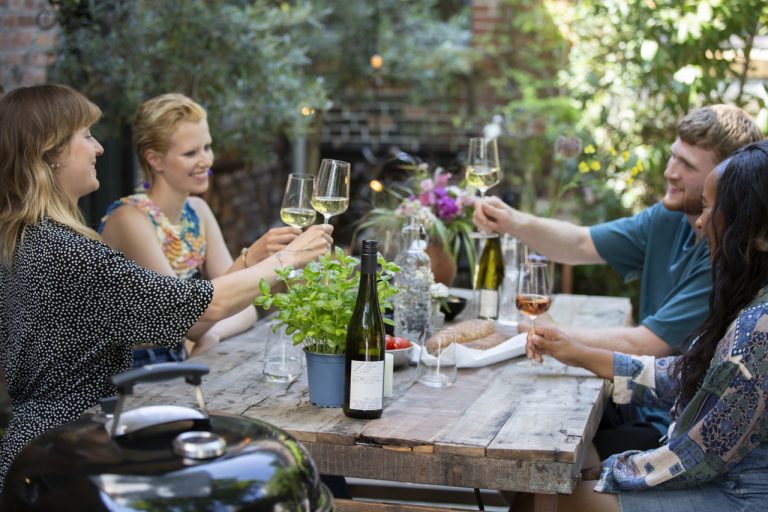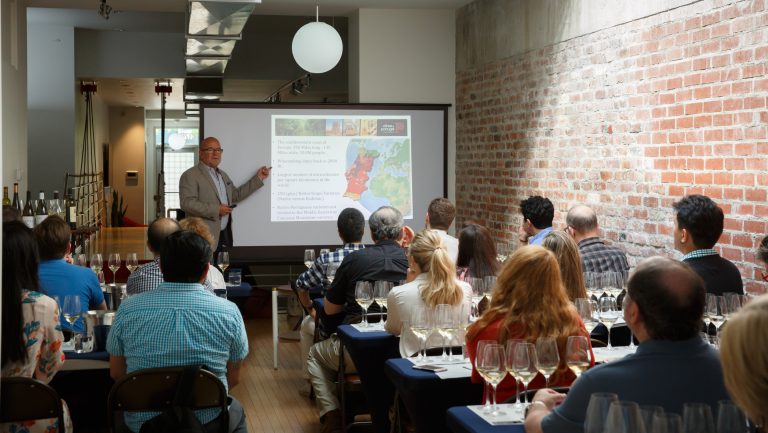This advertising content was produced in collaboration with our partner, Wines of Germany.
The viral rosé craze that has held the wine industry captive over the past decade has exploded all the old hierarchies of taste and radically revised our assumptions about where great pink wine is made. No longer associated with a few (mostly Mediterranean) corners of the globe, rosé has rapidly evolved into a global phenomenon, with centers of production popping up everywhere from California to Chile to Czechia.
While this evolution comes as welcome news to wine lovers, not every new outpost of the rosé empire is created equal. But even amidst the influx of examples from both hemispheres (and literally every continent other than Antarctica), in the eyes of many, Germany has solidified its status as the most thrilling—and singularly unique—hotbed for the style to surface on the modern map. Unlikely as it might have seemed ten or fifteen years ago, if you were to poll a cross-section of today’s most influential sommeliers and industry professionals, the verdict would be unanimous: Germany’s new wave of electrifyingly fresh, mineral-driven rosés rank among the greatest expressions made anywhere on earth.
An intricate confluence of factors conspired to transform the category into an essential fixture of the modern pink wine canon—not least of which was the American wine industry’s earlier discovery of German Riesling. After all, Germany’s historic claim to fame has always rested upon its incomparable genius with that grape, the greatest examples of which have come to inspire religious levels of devotion among the trade. To Steffen Schindler, the marketing director at the German Wine Institute, it would be impossible to imagine the ascension of German rosé without the German Riesling renaissance that swept the U.S. market just a few years previously.

Don’t miss the latest drinks industry news and insights. Sign up for our award-winning newsletters and get insider intel, resources, and trends delivered to your inbox every week.
“German Riesling has experienced an evolution of its own,” says Schindler, citing the general push toward drier styles of the grape known as the Trockenwelle, or “dry wave,” that rippled throughout Germany’s wine industry during the final decades of the twentieth century. “With 48 percent of our production now trocken, or dry, this marks a 31 percent increase in the production of dry wines over a thirty-year period.”
By the time the mid-aughts rolled around, evidence of this shift first started to register stateside. No longer suffering under the misapprehension that Riesling is categorically sweet (although it’s worth mentioning that Germany’s fruity, or fruchtig, versions of the grape rank among the greatest whites made), U.S. audiences were finally ready to discover one of the world’s most historic and culturally significant wines. It wouldn’t take long for that same generation of Riesling converts to turn their attention to the vibrant wave of German rosés that began to materialize on restaurant lists and retail shelves soon after. “As our wines become drier, the increased appetite for exploration from younger consumers has allowed for the wider discovery of German rosé,” Schindler explains.
In the intervening years, with plantings of red grapes steadily on the rise and rosé production booming across Germany’s storied wine regions, it’s clear that the category has transcended the realm of novelty or fad. In fact, the Teutonic school’s popularity has effectively ushered in an entirely new pink wine paradigm that, both in theory and in practice, offers up a powerful counterpoint to the popular image of rosé as a sunny Mediterranean phenomenon. Defined by the extreme freshness, minerality, and crystalline transparency that could come from nowhere but Germany’s northerly climes, these wines represent rosé as interpreted by the same star winemakers responsible for turning out some of the world’s purest, electrifying whites.
“Germany makes the best cool climate wines, no matter the style, so their rosé goes along with that,” says Clara Dalzell, Consultant at Manhattan’s Flatiron Wine & Spirits and an early champion of German rosé. “Although you can’t describe an entire country in one sentence, since the offerings can be so diverse, three main stylistic points tie them together: [the wines are uniformly] high in acid, mineral, and delicate.”
Beyond delivering the mouthwatering acidity and lower alcohol levels that have become emblems of contemporary taste, German rosé shares another main selling point with the country’s celebrated whites. As any die-hard German wine geek will tell you, the cult following German Riesling commands today directly results from the grape’s unrivaled ability to translate the subtle nuances of site and soil. It turns out that German rosé offers a similar conduit for the expression of place. As Schindler reminds us, it’s no coincidence that Spätburgunder (aka Pinot Noir), the star grape of German rosé, is “often described as the red equivalent of Riesling for its expressiveness of terroir.”
As the category continues to consolidate the market, it’s increasingly possible to detect regional distinctions emerging between the country’s various rosé-producing areas. Stylistically, these divisions break down lines that will already be familiar to Riesling fans, with the areas known for riper, richer Rieslings yielding fuller, fleshier rosés. “Württemberg, Baden, and southern Pfalz rosés tend to have a little more body and ripeness of fruit,” says Schindler, “while those from more northerly regions like upper Pfalz, Rheinhessen, Mosel, and Ahr are progressively more delicate.”

Fortunately, at a time when the wider rosé market finds itself increasingly divided between cheap, mass-market bottlings, on the one hand, and the luxury aspirations that have pushed so many Provençal efforts beyond the reach of ordinary consumers, Germany has managed to strike a rare balance between world-class quality and the everyday affordability that always comprised rosé’s original promise.
To Dalzell, this winning combination of unbeatable value, German quality control, and unrivaled winemaking talent adds up to an “elevated rosé experience” that is without equal in today’s increasingly crowded pink wine landscape. For now, German wines in all categories are still some of the fairest prices in the world of wine,” Dalzell says. “Their rosé is no exception. Whatever you are spending, with really top quality starting at the $20 mark, you are going to get something delicious, pure, and elegant.”
More than anything, this quintessentially German guarantee has left no doubt of the country’s central place in the contemporary pink wine pantheon, ensuring that German rosé will continue to attract the attention of quality-minded consumers and buyers alike—just like German Riesling has—in the decades to come.

Dispatch
Sign up for our award-winning newsletter
Don’t miss the latest drinks industry news and insights—delivered to your inbox every week.









